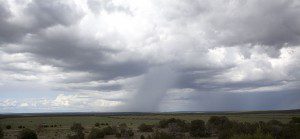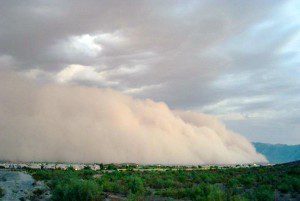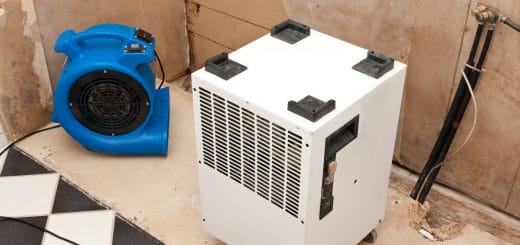Monsoon Facts and Safety Tips
The spring and summer seasons usually bring more rain to much of the United States, but for many areas in the southwest, residents are living under the conditions of a monsoon. A monsoon is a seasonally changing weather pattern that includes reversal of the wind and changes in atmospheric circulation and precipitation. In the United States, monsoon season lasts from mid-June until the end of September and this season is commonly referred to as the rainy season because of the amount of rain that monsoons cause. In addition to heavy rain, monsoons can cause severe lightning and thunderstorms, strong winds, dust storms, high temperatures, and wildfires. The North American monsoon mainly affects the southwestern states including Nevada, Arizona, New Mexico, Utah, Colorado, and parts of Texas and California.
Life Cycle of a Monsoon
Monsoons occur in the summer when the land heats up to a warmer temperature than the ocean, and the air above land expands which causes a drop in pressure while the air above the ocean remains a higher pressure. This results in sea breezes of moist air that come from the ocean and rise over land before moving back to the ocean. As the monsoon air rises over land, it cools in temperature and can no longer hold in moisture, which causes heavy rain. This entire cycle is reversed during the winter as the cooler temperatures cause the land to cool faster than the ocean with high pressure air that sends breezes over the ocean where they rise in the lower pressure air and cause precipitation. The amount of precipitation caused by the monsoon in the summer varies depending on the exact conditions but monsoons rains tend to be pretty severe.
Facts about Monsoon Season
The conditions created by the monsoon can result in flash floods, strong winds, lightning, dust storms, extreme heat, and even wildfires. It has been estimated that monsoons in the southwest U.S. cause around 10 deaths and 60 injuries per year, in addition to millions of dollars’ worth of property damage.
The following are some striking monsoon facts to keep in mind:
- Tucson, AZ has a high average rainfall of just over 6 inches during monsoon season while El Paso, TX averages 5.14 inches and Albuquerque, NM averages 4.12 inches.
- Arizona and New Mexico experience about 1.5 million lightning strikes.
- An average of 10 tornadoes per year strike within New Mexico and winds from a thunderstorm can exceed 100 mph throughout the region during monsoon season.
Staying Safe during Monsoon Season
With so many serious weather conditions that can potentially be caused by monsoons, it is important for those who live in affected regions to always be prepared and know how to react to the various bad weather conditions.
The following are basic monsoon safety tips:
- Pay attention to all weather forecasts and news in your area.
- Subscribe to severe weather notification services or apps for constant updates.
- Always be aware of your surroundings and look at the sky to assess any threat.
- Put together a supply kit that includes water, non-perishable food, first aid kit, flashlight, radio, batteries, and any medication needed.
Flash Floods from a Monsoon
One of the most serious consequences of monsoon rain is flash floodingFlooding is the overflow or accumulation of water in areas t... More. The potential for heavy bursts of rain over mostly desert areas of the southwest results in dangerous flash floods because the soil has been hardened by the sun and cannot absorb the excess water. This leaves the rain with nowhere to go, and it can quickly build and travel to cause widespread damage. The following tips will help you stay safe during a flash flood:
- Always have an evacuation plan so you and your family can escape safely.
- Keep important materials and supplies stored above flood level.
- Secure loose objects so they will not get carried away by the current of the flood.
- Immediately seek high ground when a flood begins.
- Avoid driving if you can, otherwise consult these tips for safe driving in a flood.
- Talk to your insurance provider about coverage for flood damage. Many homeowner’s insuranceHomeowner’s insurance is a policy that provides financial ... More policies do not cover flood damage and it is wise to consider adding flood insurance if your area is prone to flash floods.
Monsoon Dust Storms
Dust storms are another unique phenomenon of monsoons caused by strong winds over desert areas. These storms have the potential to be very dangerous and it is important to follow these tips to stay safe:
-
- Strong winds can very quickly lift clouds of dust that drastically reduce visibility. If you are driving when a dust storm occurs, immediately pull off the road, put your vehicle in park, and turn off the lights so that other cars do not hit you from behind.
- Dust storms can last anywhere from a couple minutes to an hour or more. It is best to remain where you are until the storm is over.
- A dust storm is always a possibility to occur throughout monsoon season so always be prepared to react to the dust and limited visibility.
Monsoons in the American Southwest are responsible for extreme weather conditions and knowing these conditions as well as how to react is the best way to protect your family and your property. Residents in these areas should always be in high alert during monsoon season and have their supplies and evacuation plans ready in case they are needed. If your home or property does sustain storm damage due to severe monsoon weather, contact a professional to handle the storm damage restoration immediately. They will immediately stabilize your home or building to prevent further damage and get it rebuilt to its original condition.














